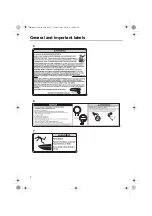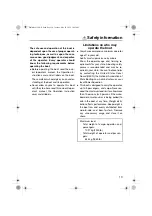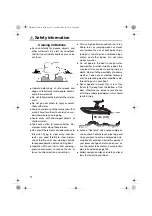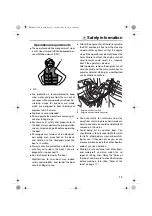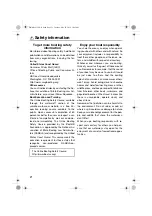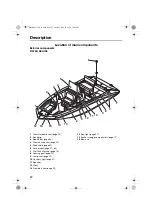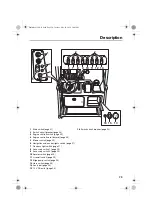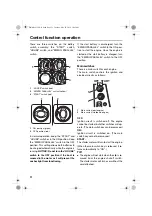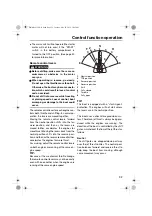
Safety information
17
Rules of the road
Your Yamaha boat is legally considered a
powerboat. Operation of the boat must be
in accordance with the rules and regula-
tions governing the waterway on which it
is used.
Just as there are rules that apply when you
are driving on streets and highways, there are
waterway rules that apply when you are oper-
ating your boat. These rules are used interna-
tionally, and are also enforced by the United
States Coast Guard and local agencies. You
should be aware of these rules, and follow
them whenever you encounter another vessel
on the water.
Several sets of rules prevail according to
geographic location, but are all basically the
same as the International Rules of the Road.
The rules presented here in this owner’s/op-
erator’s manual are condensed, and have
been provided for your convenience only.
Consult your local U.S. Coast Guard Auxiliary
or Department of Motor Vehicles for a com-
plete set of rules governing the waters in
which you will be operating your boat.
Steering and sailing rules
Whenever two vessels on the water meet one
another, one vessel has the right-of-way; it is
called the “stand-on” vessel. The vessel that
does not have the right-of-way is called the
“give-way” or “burdened” vessel. These rules
determine which vessel has the right-of-way,
and what each vessel should do.
Stand-on vessel
The vessel with the right-of-way has the duty
to continue its course and speed, except to
avoid an immediate collision. When you
maintain your direction and speed, the other
vessel will be able to determine how best to
avoid you.
Give-way vessel
The vessel which does not have the right-of-
way has the duty to take positive and timely
action to stay out of the way of the stand-on
vessel. Normally, you should not cross in
front of the vessel with the right-of-way. You
should slow down or change directions brief-
ly and pass behind the other vessel. You
should always move in such a way that the
operator of the other vessel can see what you
are doing.
The General Prudential Rule regarding the
right-of-way is that if a collision appears un-
avoidable, neither boat has the right-of-way.
Both boats must avoid the collision.
In other words, follow the standard rules ex-
cept when a collision will occur unless both
vessels try to avoid each other. If that is the
case, both vessels become give-way ves-
sels.
Rules when encountering vessels
There are three main situations that you may
encounter with other vessels which could
lead to a collision unless the Steering Rules
are followed:
Meeting: you are approaching another vessel
head-on.
Crossing: you are traveling across another
vessel’s path.
Overtaking: you are passing or being passed
by another vessel.
SportsBoat_F4A12.book Page 17 Tuesday, May 28, 2019 10:42 AM
Содержание 210FSH SPORT 2020
Страница 14: ...General and important labels 7 6 7 5 SportsBoat_F4A12 book Page 7 Tuesday May 28 2019 10 42 AM ...
Страница 15: ...General and important labels 8 10 12 11 9 8 SportsBoat_F4A12 book Page 8 Tuesday May 28 2019 10 42 AM ...
Страница 138: ...131 Consumer information Limited warranty SportsBoat_F4A12 book Page 131 Tuesday May 28 2019 10 42 AM ...
Страница 139: ...Consumer information 132 SportsBoat_F4A12 book Page 132 Tuesday May 28 2019 10 42 AM ...
Страница 144: ...Index 137 Y YAMAHA EXTENDED SERVICE Y E S 133 SportsBoat_F4A12 book Page 137 Tuesday May 28 2019 10 42 AM ...
Страница 146: ...DIC183 Printed in USA June 2019 0 1 1 CR ...





